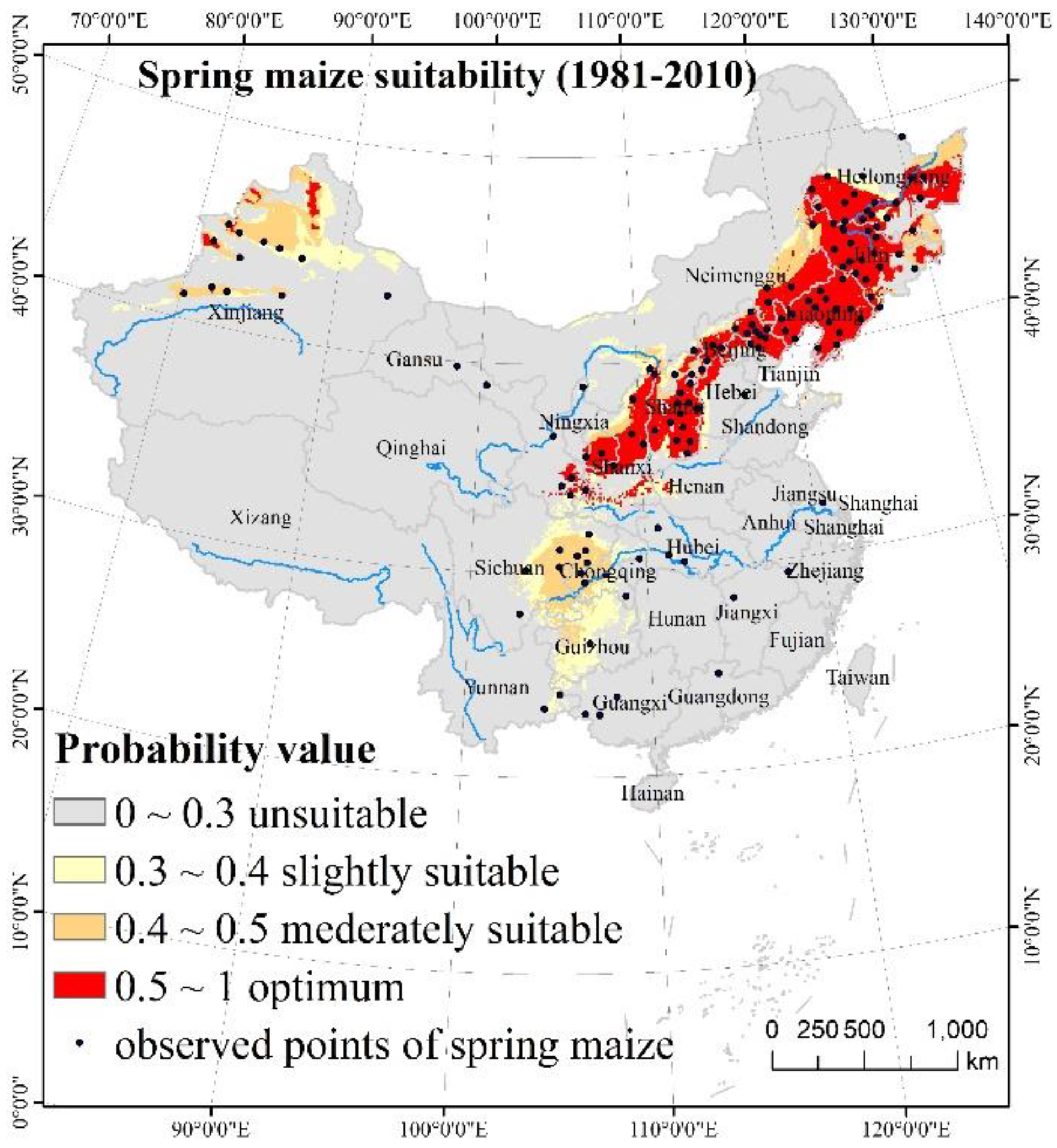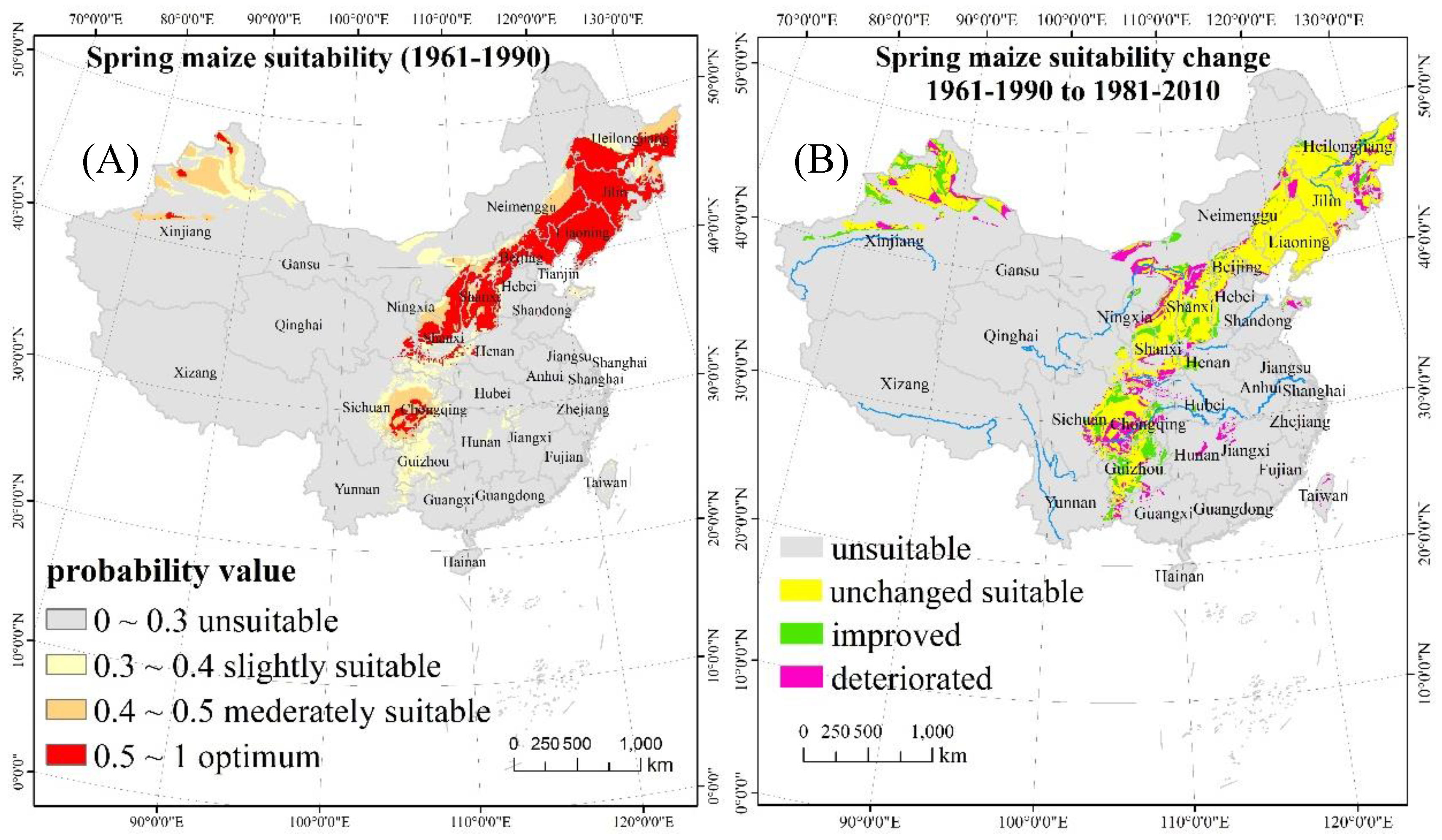The Effect of Climate Change on Spring Maize (Zea mays L.) Suitability across China
Abstract
1. Introduction
2. Methods
2.1. MaxEnt Model
2.2. Input Data
2.3. Model Calibration and Validation
2.4. Overlay Analysis
3. Results
3.1. The Beneficial and Harmful Effects on Spring Maize under Observed Climate Change
3.2. The “Tipping Point” for Spring Maize Suitability under Hypothetical Warming Scenarios
3.3. The Roles of Environmental Factors in Influencing Spring Maize Suitability
4. Discussion
5. Conclusions
Author Contributions
Acknowledgments
Conflicts of Interest
References
- Shiferaw, B.; Prasanna, B.M.; Hellin, J.; Bänziger, M. Crops that feed the world 6. Past successes and future challenges to the role played by maize in global food security. Food Secur. 2011, 3, 307–327. [Google Scholar] [CrossRef]
- Omoyo, N.N.; Wakhungu, J.; Oteng, S. Effects of climate variability on maize yield in the arid and semi-arid lands of lower eastern Kenya. Agric. Food Secur. 2015, 4, 1–13. [Google Scholar] [CrossRef]
- Xiao, D.P.; Tao, F.L. Contributions of cultivar shift, management practice and climate change to maize yield in North China Plain in 1981–2009. Int. J. Biometeorol. 2016, 60, 1111–1122. [Google Scholar] [CrossRef] [PubMed]
- Tollenaar, M.; Fridgen, J.; Tyagi, P.; Stackhouse, P.W.; Kumudini, S. The contribution of solar brightening to the US maize yield trend. Nat. Clim. Chang. 2017, 7, 275–280. [Google Scholar] [CrossRef]
- Liu, Z.J.; Yang, X.G.; Chen, F.; Wang, E.L. The effects of past climate change on the northern limits of maize planting in Northeast China. Clim. Chang. 2013, 117, 891–902. [Google Scholar] [CrossRef]
- Meng, Q.F.; Hou, P.; Lobell, D.B.; Wang, H.F.; Cui, Z.L.; Zhang, F.S.; Chen, X.P. The benefits of recent warming for maize production in high latitude China. Clim. Chang. 2014, 122, 341–349. [Google Scholar] [CrossRef]
- Zhao, J.F.; Guo, J.P.; Xu, Y.H.; Mu, J. Effects of climate change on cultivation patterns of spring maize and its climatic suitability in Northeast China. Agric. Ecosyst. Environ. 2015, 202, 178–187. [Google Scholar] [CrossRef]
- Wang, Z.Q.; Jiang, J.Y.; Liao, Y.F.; Deng, L. Risk assessment of maize drought hazard in the middle region of farming-pastoral ecotone in Northern China. Nat. Hazards 2015, 76, 1515–1534. [Google Scholar] [CrossRef]
- Deb, P.; Kiem, A.S.; Babel, M.S.; Chu, S.T.; Chakma, B. Evaluation of climate change impacts and adaptation strategies for maize cultivation in the Himalayan foothills of India. J. Water Clim. Chang. 2015, 6, 596–614. [Google Scholar] [CrossRef]
- Yan, P.; Tao, Z.Q.; Chen, Y.Q.; Zhang, X.P.; Sui, P. Spring maize kernel number and assimilate supply responses to high-temperature stress under field conditions. Agron. J. 2017, 109, 433–442. [Google Scholar] [CrossRef]
- Lobell, D.B.; Gourdji, S.M. The influence of climate change on global crop productivity. Plant Physiol. 2012, 160, 1686–1697. [Google Scholar] [CrossRef] [PubMed]
- Leng, G.Y. Keeping global warming within 1.5 °C reduces future risk of yield loss in the United States: A probabilistic modeling approach. Sci. Total Environ. 2018, 644, 52–59. [Google Scholar] [CrossRef] [PubMed]
- Zhang, Y.J.; Wang, Y.F.; Niu, H.S. Spatio-temporal variations in the areas suitable for the cultivation of rice and maize in China under future climate scenarios. Sci. Total Environ. 2017, 602, 518–531. [Google Scholar] [CrossRef] [PubMed]
- Ewert, F.; Rotter, R.P.; Bindi, M.; Webber, H.; Trnka, M.; Kersebaum, K.C.; Olesen, J.E.; van Ittersum, M.K.; Janssen, S.; Rivington, M.; et al. Crop modelling for integrated assessment of risk to food production from climate change. Environ. Model. Softw. 2015, 72, 287–303. [Google Scholar] [CrossRef]
- Babel, M.S.; Deb, P.; Soni, P. Performance evaluation of AquaCrop and DSSAT-CERES for maize under different irrigation and manure application rates in the Himalayan region of India. Agric. Res. 2018, 1–11. [Google Scholar] [CrossRef]
- Peng, B.; Guan, K.Y.; Chen, M.; Lawrence, D.M.; Pokhrel, Y.; Suyker, A.; Arkebauer, T.; Lu, Y. Improving maize growth processes in the community land model: Implementation and evaluation. Agric. For. Meteorol. 2018, 251, 64–89. [Google Scholar] [CrossRef]
- Radosavljevic, A.; Anderson, R.P. Making better MAXENT models of species distributions: Complexity, overfitting and evaluation. J. Biogeogr. 2014, 41, 629–643. [Google Scholar] [CrossRef]
- Lenton, T.M. Early warning of climate tipping points. Nat. Clim. Chang. 2011, 1, 201–209. [Google Scholar] [CrossRef]
- Holbrook, S.J.; Schmitt, R.J.; Adam, T.C.; Brooks, A.J. Coral reef resilience, tipping points and the strength of herbivory. Sci. Rep. 2016, 6, 35817. [Google Scholar] [CrossRef] [PubMed]
- Hulme, M. 1.5 °C and climate research after the Paris Agreement. Nat. Clim. Chang. 2016, 6, 222–224. [Google Scholar] [CrossRef]
- Rogelj, J.; Fricko, O.; Meinshausen, M.; Krey, V.; Zilliacus, J.J.J.; Riahi, K. Understanding the origin of Paris Agreement emission uncertainties. Nat. Commun. 2017, 8, 15748. [Google Scholar] [CrossRef] [PubMed]
- Tong, R.J.; Purser, A.; Guinan, J.; Unnithan, V. Modeling the habitat suitability for deep-water gorgonian corals based on terrain variables. Ecol. Inform. 2013, 13, 123–132. [Google Scholar] [CrossRef]
- Remya, K.; Ramachandran, A.; Jayakumar, S. Predicting the current and future suitable habitat distribution of Myristica dactyloides Gaertn. using MaxEnt model in the Eastern Ghats, India. Ecol. Eng. 2015, 82, 184–188. [Google Scholar] [CrossRef]
- VanDerWal, J.; Murphy, H.T.; Kutt, A.S.; Perkins, G.C.; Bateman, B.L.; Perry, J.J.; Reside, A.E. Focus on poleward shifts in species’ distribution underestimates the fingerprint of climate change. Nat. Clim. Chang. 2013, 3, 239–243. [Google Scholar] [CrossRef]
- Phillips, S.J.; Anderson, R.P.; Schapire, R.E. Maximum entropy modelling of species geographic distributions. Ecol. Model. 2006, 190, 231–259. [Google Scholar] [CrossRef]
- Phillips, S.J.; Dudík, M. Modeling of species distributions with Maxent: New extensions and a comprehensive evaluation. Ecography 2008, 31, 161–175. [Google Scholar] [CrossRef]
- West, A.M.; Kumar, S.; Brown, C.S.; Stohlgren, T.J.; Bromberg, J. Field validation of an invasive species Maxent model. Ecol. Inform. 2016, 36, 126–134. [Google Scholar] [CrossRef]
- Ebrahimi, A.; Farashi, A.; Rashki, A. Habitat suitability of Persian leopard (Panthera pardus saxicolor) in Iran in future. Environ. Earth Sci. 2017, 76, 697. [Google Scholar] [CrossRef]
- Scheffer, M. Foreseeing tipping points. Nature 2010, 467, 411–412. [Google Scholar] [CrossRef] [PubMed]
- Boers, N.; Marwan, N.; Barbosa, H.M.J.; Kurths, J. A deforestation-induced tipping point for the South American monsoon system. Sci. Rep. 2017, 7, 41489. [Google Scholar] [CrossRef] [PubMed]
- Zhang, L.L.; Zhang, Z.; Chen, Y.; Wei, X.; Song, X. Exposure, vulnerability, and adaptation of major maize-growing areas to extreme temperature. Nat. Hazards 2018, 91, 1257–1272. [Google Scholar] [CrossRef]





| 1961–1990 to 1981–2010 | 1961–1990 to Warming 1.5 °C | 1961–1990 to Warming 2 °C | ||
|---|---|---|---|---|
| Improved area (104 km2) | unsuitable to slightly suitable | 11.1 | 1.8 | 2.4 |
| unsuitable to moderately suitable | 0.7 | 0.2 | 0.2 | |
| unsuitable to optimum | 0.4 | 0.0 | 0.1 | |
| slightly suitable to moderately suitable | 5.7 | 1.0 | 1.4 | |
| slightly suitable to optimum | 0.6 | 0.0 | 0.1 | |
| moderately suitable to optimum | 5.2 | 0.3 | 0.2 | |
| Total | 23.7 | 3.4 | 4.4 | |
| Deteriorated area (104 km2) | slightly suitable to unsuitable | 15.2 | 1.3 | 1.8 |
| moderately suitable to unsuitable | 0.7 | 0.1 | 0.1 | |
| moderately suitable to slightly suitable | 4.8 | 0.7 | 0.8 | |
| optimum to unsuitable | 1.0 | 0.0 | 0.1 | |
| optimum to slightly suitable | 1.3 | 0.0 | 0.1 | |
| optimum to moderately suitable | 8.1 | 1.1 | 2.1 | |
| Total | 31.1 | 3.4 | 5.0 |
© 2018 by the authors. Licensee MDPI, Basel, Switzerland. This article is an open access article distributed under the terms and conditions of the Creative Commons Attribution (CC BY) license (http://creativecommons.org/licenses/by/4.0/).
Share and Cite
Ji, Y.; Zhou, G.; He, Q.; Wang, L. The Effect of Climate Change on Spring Maize (Zea mays L.) Suitability across China. Sustainability 2018, 10, 3804. https://doi.org/10.3390/su10103804
Ji Y, Zhou G, He Q, Wang L. The Effect of Climate Change on Spring Maize (Zea mays L.) Suitability across China. Sustainability. 2018; 10(10):3804. https://doi.org/10.3390/su10103804
Chicago/Turabian StyleJi, Yuhe, Guangsheng Zhou, Qijin He, and Lixia Wang. 2018. "The Effect of Climate Change on Spring Maize (Zea mays L.) Suitability across China" Sustainability 10, no. 10: 3804. https://doi.org/10.3390/su10103804
APA StyleJi, Y., Zhou, G., He, Q., & Wang, L. (2018). The Effect of Climate Change on Spring Maize (Zea mays L.) Suitability across China. Sustainability, 10(10), 3804. https://doi.org/10.3390/su10103804







